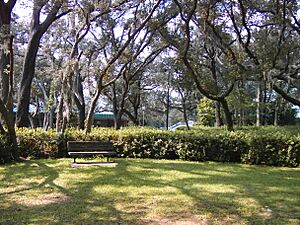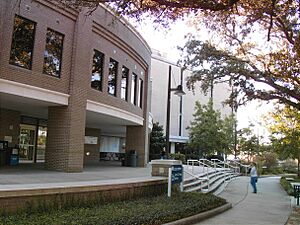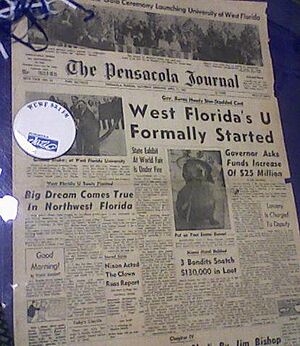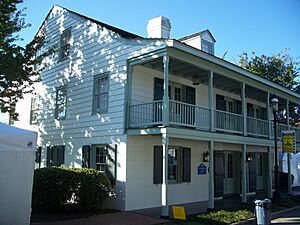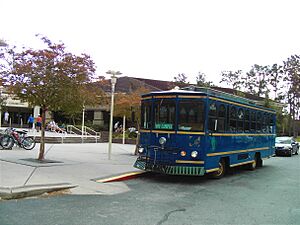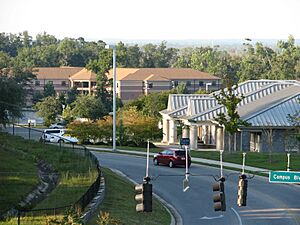University of West Florida facts for kids
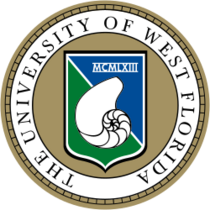 |
|
| Motto | "No Limit" |
|---|---|
| Type | Public university |
| Established | 1963 |
|
Parent institution
|
State University System of Florida |
| Accreditation | SACS |
|
Academic affiliations
|
Space-grant |
| Endowment | $74.6 million (2020) |
| President | Manny Díaz Jr. (interim) |
|
Academic staff
|
374 |
| Students | 14,343 |
| Undergraduates | 9,646 |
| Postgraduates | 4,697 |
| Location |
,
Florida
,
United States
30°32′58″N 87°13′05″W / 30.5495°N 87.2181°W |
| Campus | Small city, 1,600 acres (6.5 km2) |
| Other campuses | |
| Newspaper | The Voyager |
| Colors | Blue and green |
| Nickname |
|
|
Sporting affiliations
|
NCAA Division II – Gulf South |
| Mascot | Argie the Argonaut |
 |
|
The University of West Florida (often called West Florida or UWF) is a public university located in Pensacola, Florida, United States. It was started in 1963 and is part of the State University System of Florida.
UWF is a large university that focuses on research. It does not have schools for law or medicine. It is also a special "space-grant" institution, which means it helps with space-related research and education. Its campus is the third largest in the State University System, covering about 1,600 acres (650 ha). The university's mascot is Argie the Argonaut, and its symbol is the chambered nautilus.
Contents
History of UWF
In 1962, the Florida government decided to open a new state university in Escambia County. Harold Crosby became the first president in July 1964. UWF was the sixth university to join the State University System of Florida, which now has twelve public universities.
Construction began on April 16, 1965. In the same year, the chambered nautilus was chosen as UWF's official symbol. When it first opened, UWF was only for students who had already completed their first two years of college. These were junior, senior, and graduate students.
The first students started classes in the fall of 1967. In June 1968, 58 students were the first to graduate. By 1969, the university's programs for undergraduate students were officially recognized. Soon after, the first master's degree programs were also created.
Over the years, the university changed how its different study areas were organized. In 1979, it created three main colleges: Arts and Sciences, Business, and Education. Today, UWF has four colleges:
- College of Arts, Social Sciences and Humanities
- College of Business
- Hal Marcus College of Science and Engineering
- Usha Kundu, MD College of Health
The university also has a School of Education.
The Chambered Nautilus Symbol
Harold Crosby, UWF's first president, chose the chambered nautilus as the university's symbol. He was inspired by a poem called "The Chambered Nautilus" by Oliver Wendell Holmes. This symbol represents ideas like growth, change, and achieving goals.
How UWF Works
The University of West Florida is a public school. This means it gets most of its money from the state and from student tuition fees. A group of 13 people called the Board of Trustees helps run the university. This board includes people chosen by the Governor of Florida and other leaders.
The university's programs for students are divided into four main colleges. These colleges cover many different subjects, from arts and business to science, engineering, and health.
UWF Campuses
Pensacola Main Campus
UWF's main campus is very large, covering about 1,600 acres (6.5 km2). It has many hills and natural woodlands along the Escambia River. The campus is about ten miles (16 km) north of downtown Pensacola. The buildings are designed to fit in with the natural forest and waterways.
The John C. Pace Library at UWF is the biggest library in the Northwest Florida area. Besides the main library, there is also a smaller library branch in Fort Walton Beach, Florida. The libraries have many books, microfilms, and online journals for students to use. UWF also has another location in Fort Walton Beach called UWF on the Emerald Coast.
Historic Pensacola Village
In 2001, the university took over the management of Historic Pensacola Village. This is a group that protects and manages historic sites in Pensacola. UWF now offers classes that work with the staff at Historic Pensacola.
UWF Historic Trust
The UWF Historic Trust is a group that collects, saves, and shares the history of northwest Florida.
Arcadia Mill Complex
The Arcadia Mill complex is a very old industrial site. It is listed on the National Register of Historic Places. This was Florida's first industrial area that used water power. It had shops, mills, a railroad, and a long log flume. It operated from 1817 to 1855 and is now cared for by the University of West Florida.
Student Life at UWF
Currently, more than 14,000 students attend UWF. This includes both undergraduate (first-degree) and graduate (advanced degree) students. UWF has awarded over 100,000 degrees to its students over the years.
UWF offers many ways for students to get involved. There are many student clubs and groups, including academic clubs, Greek organizations (fraternities and sororities), and special interest groups. UWF also owns land on Pensacola Beach, which students can use for research and fun. The campus also has many mountain bike trails that students can use for free.
Student Housing
UWF offers different types of places for students to live. There are traditional dorms, smaller community dorms, and apartment complexes owned by the university. They also have "living learning communities," where students with similar interests live together and get extra help with their studies.
Greek Life
There are sixteen fraternities and sororities at UWF. These groups have over 500 members who participate in social events, community service, and leadership activities.
Getting Around Campus
UWF has a trolley service and public bicycles called "yellow bikes" to help students move around campus. There are also parking areas for everyone. Students can also get a discount on the local bus system.
UWF Athletics
The sports teams at West Florida are called the Argonauts. The university is part of the NCAA Division II level of college sports. They mainly compete in the Gulf South Conference (GSC).
West Florida has 15 different sports teams.
- Men's sports include baseball, basketball, cross country, football, golf, soccer, and tennis.
- Women's sports include basketball, cross country, golf, soccer, softball, swimming and diving, tennis, and volleyball.
Sports Achievements
UWF's sports teams have won ten national championships! Their football team most recently won the NCAA Division II Football Championship in 2019. The women's tennis team also won their 19th GSC championship, which was the university's 100th conference championship ever.
Football Team
In 2015, UWF started its first football team. They played practice games that fall. In 2016, they had their first official season and won their first game 45–0 against Ave Maria University.
In 2017, the football team made it to the NCAA Division II playoffs in only their second season. They even reached the championship game, but lost 37–27.
In 2019, UWF's football team won the NCAA Division II national championship! They beat Minnesota State University 48–40 in just their fourth season.
Notable People from UWF
Many interesting people have studied or worked at the University of West Florida.
See also
- John C. Pace Library


